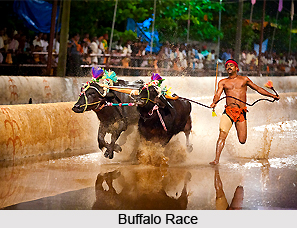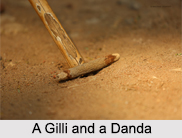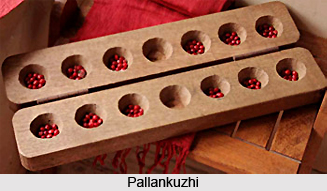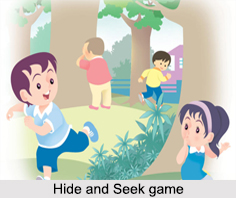 Pachisi is one of the ancient entertainment games and is also known as the "Mind Game". It is the ancestor for several modern games like the ludo, and Parchisi, which is an American adaptation of Pachisi. It was widespread in ancient time after the invasion of Greeks in India and later by Turks in the early phase of medieval era.
Pachisi is one of the ancient entertainment games and is also known as the "Mind Game". It is the ancestor for several modern games like the ludo, and Parchisi, which is an American adaptation of Pachisi. It was widespread in ancient time after the invasion of Greeks in India and later by Turks in the early phase of medieval era.
Origin of Pachisi
The origin of Pachisi can be traced back to as early as 4th century AD. People from all classes - the royalty, the noble men and also the common masses played this game, with friends or family, during leisure. There are no standard rules and so the instructions are simply typical of a number of existing variants. These rules are comprehensive instructions for friendly play. They are not a complete set of standard regulations encompassing all situations that might be encountered. If in doubt, players should always abide by locally-played or house rules.
Mythological Reference of Pachisi
Pachisi is an old domestic game, but as far as its history is concerned, there is no evidence to establish its existence prior 16th century. There is, in fact, mythological reference of Lord Shiva and Goddess Parvati playing Chaupar (a closely related game) in the 6th and 7th century. As a matter of fact, the game shoes use of dice but no proper board.
Pachisi in Mahabharata
Apparently there is a mention of Chauper being in the Mahabharata, between two sets of princes- Pandavas and Kauravas. During the play, Kauravas defeated the Pandavas by devious means, which later ended up in the battle of kurukshetra that led to complete destruction of the former.
Pachisi in Medieval Era
The game of Pachisi was a common practise in the courtroom of Akbar. And it is rather played in a royal manner. The court, treated as board, was divided into white and red squares, and a huge stone was raised on four feet, depicting the pivotal point. It was here the great Mughal Emperor Akbar, played the game with his courtiers. The role of the pieces was played by 16 young slaves from the harem, who wore the colour of players, and moved to the square boxes according to the dice throw. It is often said that Akbar was fascinated by the game that he actually had a court for pachisi constructed in all his palaces, and remnant of such are still available at cities like Agra and Allahabad.
Equipments Used in Pachisi
The game of Pachisi is played on a board in the shape of a cross, each arm being divided into three adjacent columns of eight squares. The four arms/limbs of the Pachisi board are conjoined at the center called "Char Koni". Each arm has three marked squares in orange colour called `castles` to distinguish them from the maroon squares. The pawns are 16 in number, generally shaped like a beehive and are in colours of yellow, black, red, and green. The players throw cowrie shells on the Char Koni. The number of shells that fall with the face upwards determines the moves of the pawns. The objective of each player is to get all his allocated four pawns complete the round of the board as fast as possible. 6 small cowry shells provide the element of chance that, when thrown, indicate an amount according to the following rules:
2 cowries with mouths up - 2
3 cowries with mouths up - 3
4 cowries with mouths up - 4
5 cowries with mouths up - 5
6 cowries with mouths up - 6 + grace
1 cowries with mouths up - 10 + grace
0 cowries with mouths up - 25 + grace
A grace is a special allowance of additional chance to throw the shells.
Players Used in Pachisi
Four players, with two players teaming up as partners, can play the game. Partners sit opposite each other like in a game of carrom. Yellow and Black play against Red and Green! Two players can also play this game, however it is played in the same manner as a four-player game, where one player plays Yellow and Black and the other plays Red and Green.
Plot in Pachisi
Moves are decided by throws of the cowry shells. To begin a turn, the player throws the cowries. The player moves a piece as per the number indicated in cowries. Only when a grace a thrown, the piece moved can be played out of the Charkoni onto the board, if desired, and the player is allowed another throw and continue until a 2, 3, 4 or 5 is thrown. The first piece to leave the Charkoni for each player can depart using any number. All subsequent pieces are only allowed to start or re-enter the game using a grace throw. More than one piece from the same side can occupy the same square. A piece is not allowed to finish on a castle square that is occupied by one or more enemy pieces. If a piece finishes on a non-castle square inhabited by one or more enemy pieces, the enemy pieces are captured. Captured pieces are returned to the Charkoni from where they must start again with a grace. A player making a capture is allowed another throw of the cowries to be taken immediately.
Moving in Pachisi
Moving is not compulsory and a player may decide not to move after he throws the shells. This is done in order to remain safely within a castle square or to help a partner. A common strategy is for a piece to remain up on the castle square at the end of the third arm until a 25 is thrown, thus allowing that piece to finish without risk. It is possible for a piece, upon completing its circuit, to carry on around the board for a second time. This is often done in order to assist a partner who is lagging behind. Pieces finish the game by re-entering the Charkoni, having completed a circuit of the board. However, a player is only allowed to move a piece into the Charkoni by throwing the exact number required.



















